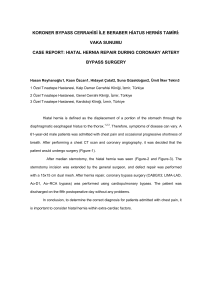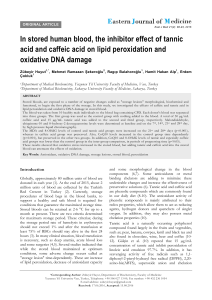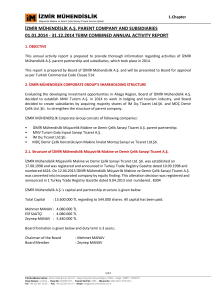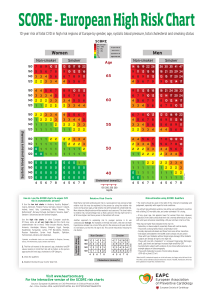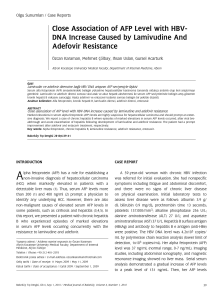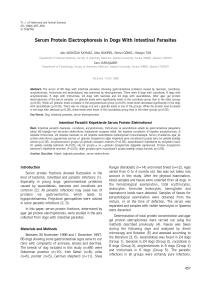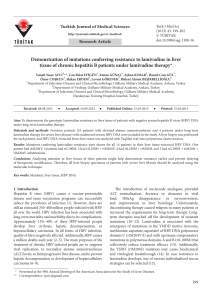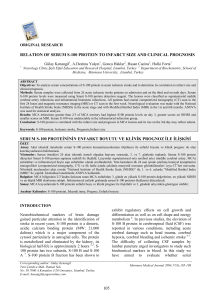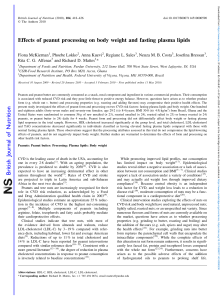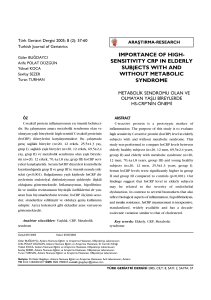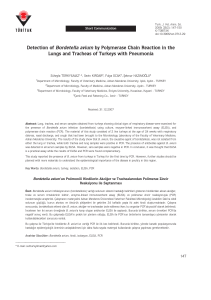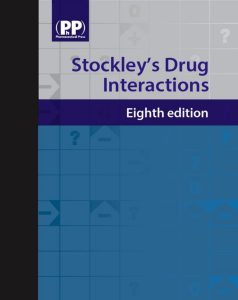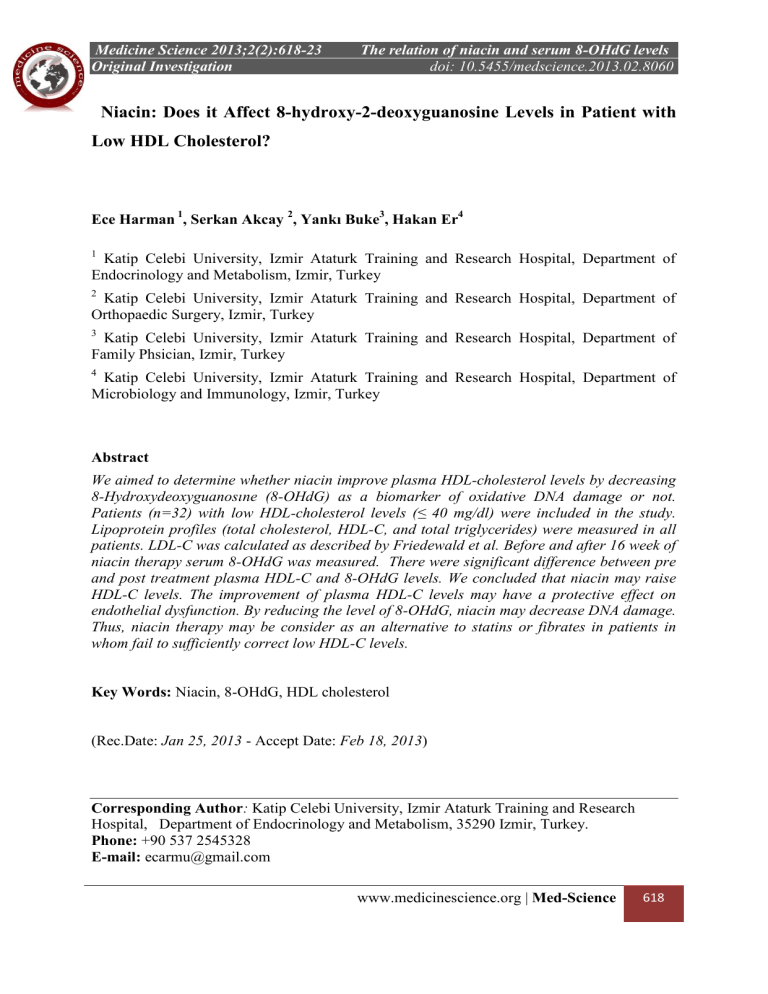
Medicine Science 2013;2(2):618-23
Original Investigation
The relation of niacin and serum 8-OHdG levels
doi: 10.5455/medscience.2013.02.8060
Niacin: Does it Affect 8-hydroxy-2-deoxyguanosine Levels in Patient with
Low HDL Cholesterol?
Ece Harman 1, Serkan Akcay 2, Yankı Buke3, Hakan Er4
1
Katip Celebi University, Izmir Ataturk Training and Research Hospital, Department of
Endocrinology and Metabolism, Izmir, Turkey
2
Katip Celebi University, Izmir Ataturk Training and Research Hospital, Department of
Orthopaedic Surgery, Izmir, Turkey
3
Katip Celebi University, Izmir Ataturk Training and Research Hospital, Department of
Family Phsician, Izmir, Turkey
4
Katip Celebi University, Izmir Ataturk Training and Research Hospital, Department of
Microbiology and Immunology, Izmir, Turkey
Abstract
We aimed to determine whether niacin improve plasma HDL-cholesterol levels by decreasing
8-Hydroxydeoxyguanosıne (8-OHdG) as a biomarker of oxidative DNA damage or not.
Patients (n=32) with low HDL-cholesterol levels (≤ 40 mg/dl) were included in the study.
Lipoprotein profiles (total cholesterol, HDL-C, and total triglycerides) were measured in all
patients. LDL-C was calculated as described by Friedewald et al. Before and after 16 week of
niacin therapy serum 8-OHdG was measured. There were significant difference between pre
and post treatment plasma HDL-C and 8-OHdG levels. We concluded that niacin may raise
HDL-C levels. The improvement of plasma HDL-C levels may have a protective effect on
endothelial dysfunction. By reducing the level of 8-OHdG, niacin may decrease DNA damage.
Thus, niacin therapy may be consider as an alternative to statins or fibrates in patients in
whom fail to sufficiently correct low HDL-C levels.
Key Words: Niacin, 8-OHdG, HDL cholesterol
(Rec.Date: Jan 25, 2013 - Accept Date: Feb 18, 2013)
Corresponding Author: Katip Celebi University, Izmir Ataturk Training and Research
Hospital, Department of Endocrinology and Metabolism, 35290 Izmir, Turkey.
Phone: +90 537 2545328
E-mail: [email protected]
www.medicinescience.org | Med-Science
618
Medicine Science 2013;2(2):618-23
Original Investigation
The relation of niacin and serum 8-OHdG levels
doi: 10.5455/medscience.2013.02.8060
Introduction
Niacin (nicotinic acid) has been used for more than 30 years to treat plasma lipid disorders
and to prevent atherosclerotic cardiovascular disease [1]. Niaspan prolonged release tablets
contain the active ingredient nicotinic acid (also known as niacin), which is a member of the
group of B vitamins. Niacin blocks fatty acid flux from adipose tissue. It also suppresses
hepatic assembly and release of very low-density lipoprotein; this latter effect reduces TG
levels and decreases the number of small dense LDL particles. Niacin may also block a
putative HDL holoparticle catabolic receptor responsible for intrahepatic degradation of HDL,
thereby increasing the effective half-life of HDL and raising HDL-C concentrations [2].
Low levels of HDL, also known as hypoalphalipoproteinemia (HA), includes a variety of
conditions, ranging from mild to severe, in which plasma concentrations of alpha lipoproteins
or HDL [3]. The US National Cholesterol Education Program (NCEP) Adult Treatment Panel
III (ATP III) redefined the HDL level that constitutes a formal cardiovascular disease (CHD)
risk factor. Treatment of isolated low HDL has gained increasing importance in the literature
in the recent years. According to the ATP III, if a patient’s TG levels are below 200 mg/dl and
HDL is low (isolated low HDL), the administration of drugs that increase HDL (fibrates or
nicotinic acid) can be considered. Statins exert only a modest effect [3].
8-OHdG is a biomarker of cellular oxidative stress but might also be a risk factor for
atherosclerosis and diabetes. The oxidative hydroxylation of guanine in the 8-position is the
most frequent and most mutagenic lesion in nuclear DNA. Many authors have examined the
relationship between oxidative stress and several diseases such as cancer, obesity, diabetes,
and hypercholesterolemia.
Recent data have indicated that niacin also decreases C-reactive protein levels, improves
endothelial dysfunction, increases the endothelial and leukocyte oxidation-reduction (redox)
state in vitro, inhibits cytokine-induced monocyte adhesion to human endothelial cells,
improves plaque stability, and reduces thrombosis [4,5,6]. Thus, we aimed to evaluate HDL-C
and 8-OHdG levels after niacin treatment.
www.medicinescience.org | Med-Science
619
Medicine Science 2013;2(2):618-23
Original Investigation
The relation of niacin and serum 8-OHdG levels
doi: 10.5455/medscience.2013.02.8060
Subject and Methods
Patients (32 male) having low HDL cholesterol levels (≤ 40 mg/dl) and control subjects (20
male) were included in the study. Written informed consent was obtained from all participants
prior to enrollment into study. The study protocol was conducted according to the guidelines
of the Declaration of Helsinki and had been approved by the local Ethic Committee. Subjects
were excluded from the study for diabetes, renal disease, liver disease, gout, hyperuricemia,
peptic ulcer disease, history of myositis, untreated hypothyroidism, and cancer. All patients
underwent niacin prolonged release tablets (niaspan, Abbott). Niacin tablets were dispensed at
4-week intervals in increasing doses of 50,250, and 500 mg twice daily. Normal maintenance
dose was 1500 mg every night at bedtime. Blood samples were collected in the first visit
(pretreatment) and second visit (16-weeks after initiation of therapy). Serum 8-OHdG was
measured using an ELİSA Kit, Cayman Chemical, USA. The test utilizes an anti-mouse IgGcoated plate and a tracer consisting of an 8-OHdG conjugate. This format has the advantage
of providing low variability and increased sensivity compared with assays that utilize an
antigen-coated plate. Procedure was as described in the protocol provided by the
manufacturer. Absorbance was measured at 450 nm using an Microplate Reader Multiscan FC
(Thermo-Scientific).
Lipoprotein profiles (total cholesterol, HDL-C, and total triglycerides) were measured on
plasma samples, obtained after an overnight fast. LDL-C was calculated. Statistical analysis
of data was performed with 95% confidence at windows package program. Mann Whitney U
test was used for comparison of data between groups. p<0.05 value was considered to be
statistically significant.
www.medicinescience.org | Med-Science
620
Medicine Science 2013;2(2):618-23
Original Investigation
The relation of niacin and serum 8-OHdG levels
doi: 10.5455/medscience.2013.02.8060
Results
The distribution of the groups in terms of age and gender were similar. The data of the
subjects are shown in table 1. The mean duration of treatment was 16 weeks for the patients.
Table 1. Demographic data and laboratory parameters of subjects
Control
Patient Group
Group
(pre-treatment)
50,4±3,53
50,7±5,27
0.85
Gender (Male)
20
32
-
HDL
(mg/dl)
41±1,3
39±1,2
<0,01
TG
(mg/dl)
268±17,4
278±22,5
>0,05
LDL
(mg/dl)
97±3,8
105±3,9
>0,05
0,27±0,03
0,26±0,03
>0,05
Age
(year)
p value
8-OHdG (ng/ml)
(mean±SD)
8-OHdG levels was 0,26±0,03 in period of pretreatment. But, it was measured 0,25±0,02 after
treatment. Ultimately, we detected that there was statistically significant decrease at 8-OHdG
levels after treatment (p=0,036). Similarly, It was found statistically significant increase at
serum HDL-C levels (p=0,01) (Table 2).
Table 2. Serum HDL-C levels
HDL
(mg/dl)
8-OHdG (ng/ml)
(mean±SD)
Patient Group
(pre-treatment)
Patient Group
(post-treatment)
p value
39±1,2
41±1,3
<0,01
0,26±0.03
0,25±0,02
<0,05
www.medicinescience.org | Med-Science
621
Medicine Science 2013;2(2):618-23
Original Investigation
The relation of niacin and serum 8-OHdG levels
doi: 10.5455/medscience.2013.02.8060
Discussion
The use and effects of niacin on plasma lipoproteins were first described over fifty years ago.
Niacin was the first drug to show efficiency in reduction of both major cardiovascular events
and mortality in patients with prior myocardial infarction [7]. The routine use of early
preparations of niacin was limited by side effect profile. Niacin has been superseded in recent
years with the advent of newer lipid-modulating interventions [3,4,8]. However, whether
niacin itself is used routinely in the future will depend on the outcomes of two large outcome
trial (AIM-HIGH and HPS2-THRIVE) [9,10]. There are conflictive effects besides positive
effects of niacin on lipid profile. However, it should be considered priority at treatment.
Because, niacin may reduces the DNA damage and inflammation. This “pleiotropic” role may
well play a significant role in the benefical effect of niacin on cardiovascular outcomes both
systemically and at a local/cellular level. Ultimately, we wanted to emphasize that the niasin
treatment should be kept in mind priority in routine practice.
Conclusion
Our results suggest that beside the HDL-C decreasing effect, niacin may decrease DNA
damage by reducing the level of 8-OHdG.
Abbreviations: HDL-C (High density lipoprotein cholesterol), LDL-C (Low density
lipoprotein cholesterol), TG (Triglyceride), 8 OHdG (8 hydroxy-2-deoxyguanosine)
www.medicinescience.org | Med-Science
622
Medicine Science 2013;2(2):618-23
Original Investigation
The relation of niacin and serum 8-OHdG levels
doi: 10.5455/medscience.2013.02.8060
References
1. Meyers CD, Kamanna VS, Kashyap ML. Niacin therapy in atherosclerosis. Curr Opin
Lipidol. 2004;15(6):659-65.
2. Kamanna VS, Kashyap ML. Mechanism of action of niacin on lipoprotein
metabolism. Curr Atheroscler Rep. 2000;2(1):36-46.
3. Singh V, Sharma R, Kumar A, Deedwania P. Low high-density lipoprotein
cholesterol: current status and future strategies for management. Vasc Health Risk
Manag. 2010;29(6):979-96.
4. Wu BJ, Yan L, Charlton F, Witting P, Barter PJ, Rye KA. Evidence that niacin
inhibits acute vascular inflammation and improves endothelial dysfunction
independent of changes in plasma lipids. Arterioscler Thromb Vasc Biol.
2010;30(5):968-75.
5.
Lee K, Ahn TH, Kang WC, Han SH, Choi IS, Shin EK. The effects of statin and
niacin on plaque stability, plaque regression, inflammation and oxidative stres in
patients with mild to moderate coronary artery stenosis. Korean Circ J.
2011;41(11):641-8.
6. Wu BJ, Chen K, Barter PJ, Rye KA. Niacin inhibits vascular inflammation via the
induction of heme oxygenase-1. Curr Atheroscler Rep. 2012;14(1):49-59.
7. Canner PL, Berge KG, Wenger NK, Stamler J, Friedman L, Prineas RJ, Friedewald
W. Fifteen year mortality in Coronary Drug Project patients: long-term benefit with
niacin. J Am Coll Cardiol. 1986;8(6):1245-55.
8. Knopp RH, Retzlaff BM, Fish B, Dowdy A, Twaddell B, Nguyen T, Paramsothy P.
The SLIM Study: Slo-Niacin® and Atorvastatin Treatment of Lipoproteins and
Inflammatory Markers in Combined Hyperlipidemia. J Clin Lipidol. 2009;3(3):16778.
9. AIM-HIGH: Niacin plus Statin to Prevent Vascular Events. Accessed at
http://clinicaltrials.gov/ct2/show/NCT00120289
10. HPS2-THRIVE: A Randomized Trial of the Long-term Clinical Effects of Raising
HDL Cholesterol With Extended Release Niacin/Laropiprant. Accessed at
http://clinicaltrials.gov/ct2/show/NCT00461630
www.medicinescience.org | Med-Science
623

